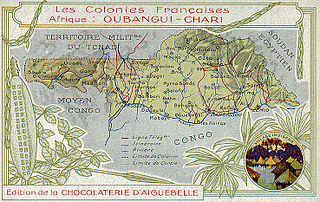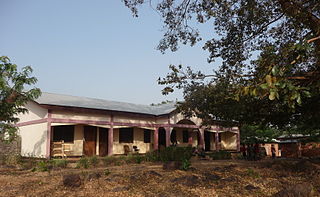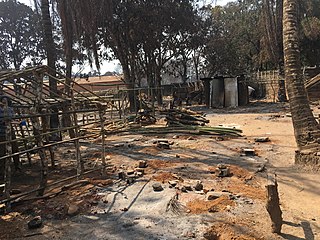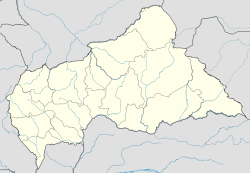
The history of the Central African Republic is roughly composed of four distinct periods. The earliest period of settlement began around 10,000 years ago when nomadic people first began to settle, farm and fish in the region. The next period began around 10,000 years prior.

Bria is the capital of Haute-Kotto, one of the 14 prefectures of the Central African Republic. As of the 2003 census the town had a population of 35,204.

Bangassou is a city in the south eastern Central African Republic, lying on the north bank of the Mbomou River. It has a population of 24,447 and is the capital of the Mbomou prefecture. It is known for its wildlife, market, and nearby Bangassou Airport and is linked by ferry to the Democratic Republic of Congo on the south bank. The city is also home to the Roman Catholic Diocese of Bangassou.
Grimari is a city located in the Ouaka prefecture in Central African Republic, approximately 222.7 kilometres (138.4 mi) away from the capital, Bangui. The politician Abel Goumba was born in Grimari.

The Central African Republic Civil War is an ongoing civil war in the Central African Republic (CAR) involving the government, rebels from the Séléka coalition, and Anti-balaka militias.

An internal conflict in the Central African Republic (CAR) started essentially on 13 April 2013, when the government of President Michel Djotodia officially took over. The fighting was between the government of the Central African Republic's former Séléka coalition of rebel groups, who are mainly from the Muslim minority, and the mainly Christian anti-balaka coalition. The conflict was part of the ongoing Central African Republic Civil War (2012–present). International organisations, such as the United Nations, had warned of a possible genocide. UNSC resolution 2122 authorised the African-led International Support Mission to the Central African Republic (MISCA) to be deployed to the country, and France to lead operations with additional troops sent to bolster its force in the country. Following a summit of Economic Community of Central African States (CEEAC), including the attendance of all the country's MPs, Djotodia resigned from the presidency on 10 January 2014. The National Transitional Council chose Bangui mayor Catherine Samba-Panza as interim president on 20 January 2014. A period of lawlessness prevailed during the early days of her presidency with people moving into religiously cleansed neighbourhoods as the UN warned of a genocide. Anti-Balaka attacks continued against Muslim civilians.

The Anti-balaka is an alliance of militia groups based in the Central African Republic in the early 21st century said to be composed primarily of Christians. However, some church leaders have contested the claimed exclusively Christian character of such groups. The Tony Blair Faith Foundation and journalist Andrew Katz have noted that animists also participate in Anti-balaka groups.

United Nations Multidimensional Integrated Stabilization Mission in the Central African Republic is a UN peacekeeping mission, which started on April 10, 2014, to protect Central African Republic civilians under Chapter VII of the UN Charter. It transformed the 6,000-strong African Union-led peacekeeping force known as MISCA into a UN peacekeeping mission and became operational on September 15, 2014. The UN deployed a transition team to set up MINUSCA and prepare for a seamless transition of authority from MISCA to MINUSCA. As of 30 September 2021, it has more than 15,000 troops, police and civilian personnel on the ground. Its role is to:
Bossemptélé is a sub-prefecture of Ouham-Pendé in the Central African Republic.
The following is a timeline of events during the Central African Republic Civil War.
From December 2018 to January 2019 heavy clashes took place in Bakouma in Central African Republic.

Since 2013 around 15,000 Muslims had been besieged in PK5 district in Bangui, Central African Republic.

Nzacko or Nzako is a village located in the Central African Republic prefecture of Mbomou on the road between Bakouma and Bria.

On 15 November 2018 at least 112 people including 19 children, 44 women and 49 men were killed in attacks on refugee camps in Alindao by UPC and Anti-balaka fighters. At least 27 people were injured including four children.

Rodrigue Ngaibona alias Andjilo is a former Anti-balaka leader in the Central African Republic, arrested in 2015 and convicted 2018 for his crimes during the civil war.
Haroun Gaye is a Central African warlord, general in the Popular Front for the Rebirth of Central African Republic (FPRC), sanctioned by international institutions.
Dimitri Placide Ayoloma – is an Anti-balaka commander from the Central African Republic, active in Ouaka and Kémo prefectures. He is responsible for multiple crimes including killing of peacekeeper, looting, arson, assault and kidnapping for ransom.












